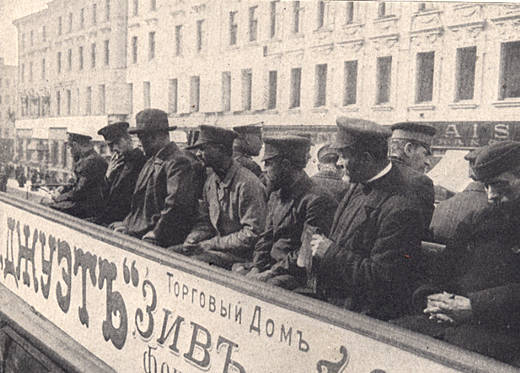   

Here we see a group of well-dressed men traveling via horse-tram. They are riding on the top in the fresh air. The top deck was a great place to observe the hustle and bustle of Nevsky Prospect and a few of the riders seem intend upon the activities below. The man closest to us has fallen asleep. These men are most probably professional workers. Tram travel was expensive and the vast majority of workers walked. The average Petersburger took around 73 tram rides in 1900, compared to 113 per year in Berlin. The tram network was inadequate for the needs of the city - Petersburg had only 71 miles of track in 1900. In comparison the city of Toronto, Canada had the same number of miles of track for a population less than a tenth the size of Petersburg.
In 1900 Petersburg was a city of aristocrats, bureaucrats and peasants. Peasants did not mean farm workers - it indicated social origin. Some peasants in Petersburg were third generation factory workers that had been born and raised in the city. A city census taken a few years later, in 1910, showed that 69% of the population of almost 2 million were of peasant background. A significant part of this population was transient, 10% left every summer to work in the fields and 13% had only just arrived in the city within the last few months when the census was taken.
In 1900 workers were at their job up to 11.5 hours a day and most factories requitered their workers to stay on the job this long. Although some Petersburg factory workers were paid fairly well by the standards of the time, their salaries were eaten up the the high cost of living in the city. Housing and food were very expensive and rising in cost every year. It has been estimated that the average working family required between 600 - 700 rubles a year to maintain an acceptable standard of living. 700 rubles in 1900 would equate to $6,800 today.
About the breakdown of workers occupations James H. Bater in his book, "St. Petersburg, Industrialization and Change" has written:
"By far the largest proportion of hired labour was found in construction, transport, handicraft, trade, institutional and personal service. Including day labourers, in total about 500,000 people were involved, roughly two and a half times the number of factory workers. The yardkeepers or dvorniki, coachmen, domestic servants and the like who were employed by government institutions or private persons were the largest group and numbered about 200,000. Roughly 170,000 worked in commerce, nearly 80,000 in transport, while construction, handicraft and day-labouring activities absorbed the remainder. Actually, the construction and day-labouring group was rather larger than the December census indicates, for it was during the summer months that navvies came in their tens of thousands to work in the building trades, at the docks, or in repairing the winter-ravaged streets. The 100,000 or so who arrived for the summer nearly equalled the number of peasants who left for the countryside. According to their trade they continued to migrate to specific parts of the city: building tradesmen like carpenters and bricklayers to Okhta, waggoners to Aleksandro-Nevskaya and adjacent boroughs, dock workers to Narvskaya, and day labourers to the central-city boroughs like Spasskaya and Moskovskaya where the hope of a job was highest among the multifarious workshops, markets or factories. If hours of work in factories seemed inordinate they were none the less very agreeable in relation to the plight of hired workers generally. In late June, there was sufficient light twenty hours of the day to permit construction; out of this period, sixteen-hour working days were quite general. In dingy workshops, production continued whether there was natural light or not. For instance, in the several hundred small bakeries, employees were on the job sixteen to nineteen hours, the remainder of the day usually being spent sleeping somewhere on the premises. Shoemakers toiled about fifteen hours daily, and so it went on throughout the handicraft and petty retail trades. An eight hour day remained a utopian notion.
At the bottom of this labouring population were the casual workers. If a factory job were obtained, men were fortunate to draw eighty kopeks a day; women, sixty; juveniles and children, thirty to forty-five.
In other sectors they frequently earned less. With dependents, hired labour represented about one million people, or more than half the total population in 1910. Clearly, there was every reason to view this seething mass of humanity with some concern. Industrialization had created a labour market of enormous dimensions, and the 1905 revolution had already demonstrated its ability to shake the existing social and political structure to its very roots."
Next photograph: The Nevsky Prospect from Above
For a small map of the St. Petersburg area click here.
To see a large map of the center
of St. Petersburg go here.
Comments on the website should be sent to Bob
Atchison. |
 |
|

